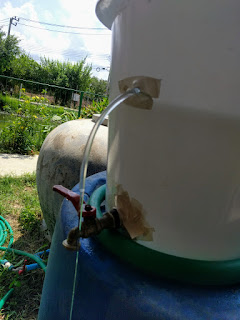In exploring the idea of using the cattails in the bathroom of BaanLoiNaam as a kind of constructed wetland water filter for the grey water coming out of the sink and shower, I was consulting with Bob Crosby of Biorealis and he mentioned something interesting about siphons.
The idea is that in a wetland like this, if the outgoing water is handled with a simple overflow pipe, there may be a tendency for gunk to build up at that water level around the walls of the filter. And if having the water level fluctuate is a good thing, the best way to achieve it without any pumps or electronics of any sort is a siphon.
If a siphon tube sits in the side of the planter box such that the top of the siphon is exactly at the level an overflow pipe might be, then whenever the water level gets up to that level, the siphon becomes filled with water which starts flowing out the siphon to the next stage of the filtration process. But once the flow starts, then the siphon is primed and the flow will continue until it approaches the level of the bottom of the siphon. This allows for a natural ebb and flow in the planter box which should prevent scum from building up at the top of the water level.
But before we actually deploy this idea, I figured it warranted a simple experiment.
So I took the cheap bucket we used in the “gravity fed shower water pressure” test we did a while back, and put a siphon in the side:
The siphon is just a small length of the plastic tubing we used for the spirulina experiment recently.
I measured it so that the output side reached about 10cm down from the top of the siphon and filled up the bucket with water:
Sure enough, when the water level reached the top of the siphon, it began flowing out, and didn’t stop until it came down almost exactly to the level of the bottom of the output part (about 10cm).
I intentionally used a fairly small piece of tubing because I worried that a larger piece might not fill up with water. (Basically, if the water can trickle down the bottom side of the siphon tube without ever filling the tube, then the siphon won’t work.) But even a small tube running constantly for a long time can move large amounts of water.
So I timed how long it took to fill up a 500ml cup, which came out to almost exactly 1 minute. At one liter every two minutes, this comes out to 720L/day, which is much more than we expect to need. We once estimated that we use about 20L of water to shower, and since there are two of us and we normally shower twice a day, this comes out to 80L of water per day for showering. If you add a couple of liters more for washing hands and some more for washing dishes, we might get up to 100L/day. So the 720L/day is plenty. And if it ever isn’t enough, we can always put a second siphon next to the first one.
So I think we are good to go using a siphon to create an ebb and flow in the water level of the constructed wetland filter/green wall in the bathroom of the floating house.



